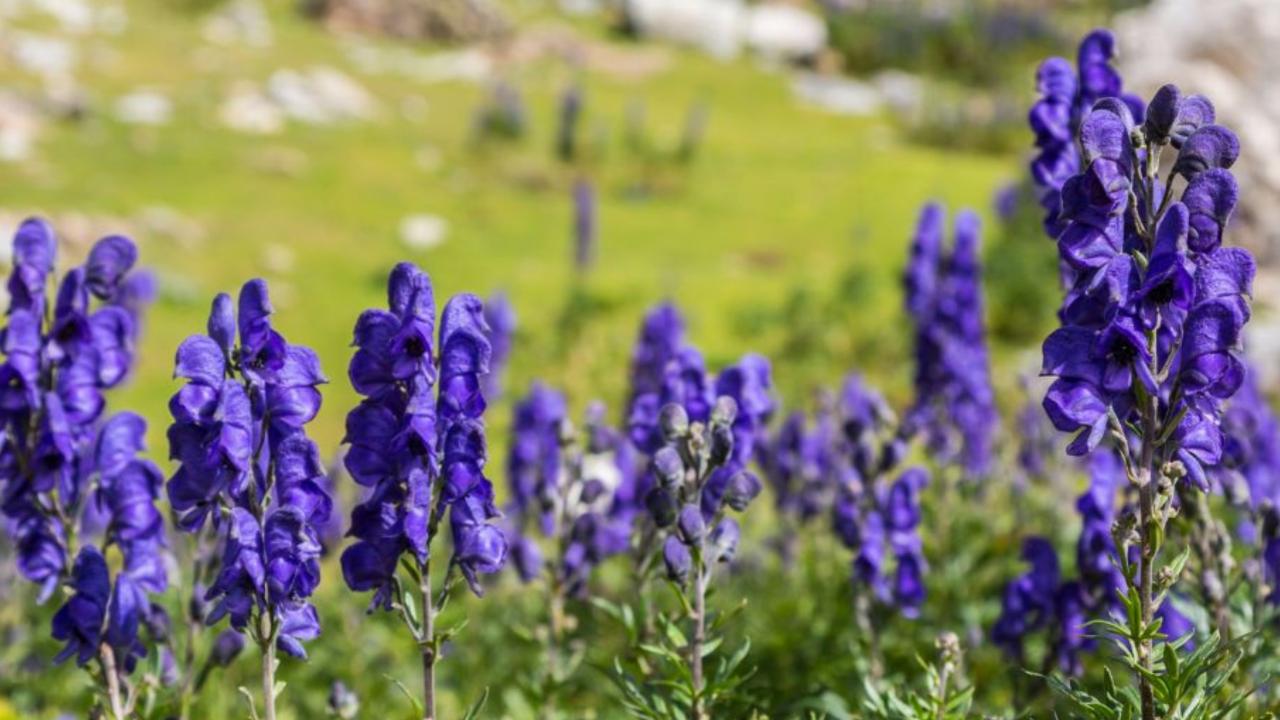Ativisha/Atis: Ayurvedic Health Benefits, Uses and Dosage
Ayurveda, an ancient healing science, reveals a wealth of natural herbs and spices endowed with remarkable healing properties. While some herbs and roots are widely recognized and employed for medicinal purposes, a multitude of therapeutic plants remains untapped, awaiting discovery.  Among these hidden treasures lies Aconitum Heterophyllum, known as Atis, a rare Ayurvedic herb concealed within the heart of the Himalayas. Despite its extraordinary healing potential, Atis often remains overlooked and underutilized.
Among these hidden treasures lies Aconitum Heterophyllum, known as Atis, a rare Ayurvedic herb concealed within the heart of the Himalayas. Despite its extraordinary healing potential, Atis often remains overlooked and underutilized.
What is Atis?
Ativisha, known as “atis” in Hindi, is an herb extensively documented in ancient Ayurvedic texts by Charaka and Sushruta. This plant’s Latin name is Aconitum heterophyllum, and it belongs to the Ranunculaceae family.
It holds a special place as one of the most effective remedies for digestive issues in children, thanks to its carminative properties that support a healthy digestive system. Interestingly, despite its toxic nature, Ativisha is esteemed as one of Ayurveda’s finest medicinal herbs.
Ayurvedic Properties of Atis
Atis, scientifically known as Aconitum Heterophyllum, is a versatile Ayurvedic herb cherished for its unique blend of bitter and pungent tastes, offering a natural remedy that balances various doshas for holistic well-being.
1. Taste (Rasa): Bitter and Pungent
Aconitum Heterophyllum, or Atis, is characterized by two primary tastes in Ayurveda: bitter (Tikta) and pungent (Katu). These tastes play a crucial role in Ayurvedic medicine. Bitter taste is often associated with detoxification and can help in purifying the body, while pungent taste has a heating quality, which can stimulate digestion and metabolism.
2. Quality (Guna): Light and Dry
Atis exhibits two qualities: light (Laghu) and dry (Ruksha). These qualities suggest that Atis has a relatively lightweight and dry nature. In Ayurveda, herbs with such qualities are often used to balance heavier and moister characteristics in the body, making them valuable for various therapeutic purposes.
3. Potency (Virya): Hot
Atis is considered to have a hot potency (Ushna). This means that it possesses warmth-inducing properties in the body. Hot herbs are often used to improve digestion, increase circulation, and provide a sense of vitality.
4. Post-Digestive Taste (Vipaka): Pungent
The post-digestive taste (Vipaka) of Atis is pungent (Katu). This indicates that after digestion, Atis imparts a pungent taste, which can continue to stimulate digestion and help in the assimilation of nutrients.
5. Dosha Effect (Dosha Karma): Balances Vata, Pitta, and Kapha Doshas
One of the remarkable qualities of Atis is its ability to balance all three doshas in Ayurveda: Vata, Pitta, and Kapha. This means that it can be used to address imbalances related to these doshas. It’s a versatile herb that can adapt to different body constitutions and health conditions, making it valuable in Ayurvedic treatments.
Tips: In Ayurveda, understanding the properties of herbs like Atis is essential for tailoring treatments to an individual’s specific constitution and health needs, promoting overall well-being and balance.
Medicinal Uses of Different Aconitum Species
Many species within the Aconitum genus are known to be poisonous. However, some species have found applications in traditional pharmaceutical formulations for various health concerns. Here are a few examples:
- Aconitum heterophyllum: Used for dyspepsia and cough.
- Aconitum kirinense: Employed in the treatment of rheumatoid disease.
- Aconitum bulleyanum: Applied for addressing rashes and as a remedy for snake bites.
- Aconitum orochryseum: Utilized to treat snake bites and dysentery.
- Aconitum carmichaeli (Fuzi): A key component in traditional East Asian medicines with applications as a diuretic and analgesic.
- Aconitum brachypodium: Known for its analgesic properties.
While these Aconitum species have been used in traditional medicine, it’s crucial to note that many of them contain toxic compounds and should be used with caution or under the guidance of a qualified healthcare practitioner.
Medicinal Properties of Ativisha (Aconitum heterophyllum)
Ativisha, scientifically known as Aconitum heterophyllum, boasts a wide range of medicinal properties, making it a versatile herb in traditional medicine. Here are its notable attributes:
1. Antipyretic: Effective in reducing fever.
2. Antiperiodic: Helps combat periodic diseases.
3. Antidote: Acts as an antidote to counteract poisons.
4. Digestive: Aids in digestion.
5. Stomachic: Supports stomach health.
6. Antiemetic: Relieves nausea and vomiting.
7. Amapachak: Functions as a detoxifier, particularly for Ama toxins.
8. Anthelmintic: Effective against parasitic worms.
9. Antidiarrheal: Helps alleviate diarrhea.
10. Aphrodisiac: Known for its aphrodisiac properties.
11. Blood purifier: Purifies the blood.
12. Antimalarial: Used in the treatment of malaria.
13. Anti-dysenteric: Effective against dysentery.
14. Breastmilk detoxifier: Enhances breast milk quality.
15. Anti-obesity: Supports weight management.
16. Antitussive: Suppresses coughing.
17. Styptic: Stops bleeding.
18. Anti-hemorrhoidal: Effective against hemorrhoids.
19. Absorbent: Absorbs excess moisture.
20. Carminative: Relieves flatulence and aids digestion.
21. Anti-inflammatory: Reduces inflammation.
22. Antimicrobial: Combats various microbes.
23. Antihyperlipidemic: Helps control high lipid levels.
24. Antioxidant: Protects against oxidative damage.
25. Antihyperglycemic: Regulates high blood sugar.
26. Anti-diabetic: Beneficial for diabetes management.
27. Hemostatic: Promotes blood clotting.
28. Hepatoprotective: Supports liver health.
Ativisha is a multi-faceted herb with applications spanning fever reduction, infection prevention, respiratory and digestive health enhancement, appetite improvement, metabolism support, and detoxification.
It aids in fat reduction, inflammation reduction, and the removal of Aam toxins from the body. Ativisha is employed in treatments related to blood, stomach, skin, lungs and airways, intestines, and liver.
It can also be beneficial for addressing conditions like IBS, Piles, and Hemorrhoids, making it a natural detoxifier for blood and body tissues, and even improving breast milk consistency.
Uses of Ativisha in Ayurveda
Atis, or Aconitum heterophyllum, is often combined with other herbs in traditional remedies to address various health concerns. Here are some examples of its usage in different combinations:
1. Pediatric Disorders: Ativisa is used alone or with karkatasrngi and long pepper to manage cough and fever in children.
2. Atisara (Diarrhea): A combination of ativisa, bhanga, and vacha (Acorus calamus) is used as a powder to treat diarrhea.
3. Jvaratisara (Fever with Diarrhea): Ginger, Kutaja, Musta, Giloy, and Ativisha are administered orally in the form of a decoction to address fever with diarrhea.
4. Grahani (Irritable Bowel Syndrome – IBS): A decoction made from ativisa, ginger, and musta is given orally to combat IBS by eliminating ama (toxic residues) from the body.
5. Mutrakrcchra (Dysuria): For dysuria, a combination of Ativisa, amla dravyas, sunti, goksura, kantakari is prepared as a peya (liquid formulation) and administered along with Phanita (sugar-based formulation).
6. Visha Roga (Poisoning): In cases of acute poisoning, a ghee prepared with ativisa and cow’s milk is used orally or as nasal drops. The ghee may also be processed with shveta Madyantika.
7. Mushika Visa (Rat Bite): To treat rat bites, Ativisa root is ground into a paste with honey and administered orally.
8. Vrana (Ulcers): A paste made from syonaka, prativisa, and kantakari moola is applied over wounds and ulcers.
9. Kuksi Roga (Colic Pain): A combination of 1 part ativisa and 3 parts ankota is administered orally with rice water to alleviate colic pain.
10. Pakvasaya Gatha Vata (Colitis): The combination of ativisa, sunti, and guduchi is considered effective in managing colitis.
11. Sthaulya (Obesity): Ativisa is used to provide beneficial results in cases of obesity.
12. Krimi (Intestinal Worm Infestation): A combination of ativisa and vidanga is beneficial in addressing intestinal worm infestations.
These combinations showcase the versatility of Atis in traditional medicine, where it is blended with other herbs to target specific health conditions and promote overall well-being.
Ayurvedic Medicines Containing Ativisa
Proprietary Ayurvedic Medicines Containing Ativisa (Aconitum heterophyllum) as an Ingredient, Ativisa is a valuable component in various proprietary Ayurvedic medicines, contributing to their effectiveness in addressing specific health issues. Here are some proprietary medicines that include Ativisa as an ingredient:
1. Pranamritha (Digestive Syrup): Supports digestion.
2. Mebarid Syrup (Diarrhea): Used to manage diarrhea.
3. Curill Syrup (Fever, Common Cold): Effective against fever and common cold.
4. Colicarmin Drops (Pediatric Disorders): Beneficial for pediatric health issues.
5. Pavanam Capsules (Rheumatoid Arthritis): Helps with rheumatoid arthritis.
6. Atrisor Capsules (Psoriasis): Used in the management of psoriasis.
7. Livdap Capsules (Jaundice): Supports liver health in cases of jaundice.
8. Amritharista (Fever): Effective against fever.
9. Amoebica Capsule: Used for amoebic infections.
10. Kutaja Compound Capsule (Chronic Diarrhea): Effective in cases of chronic diarrhea.
11. Phyto-Liv-Syrup (Liver Disorder): Supports liver health.
12. Ambimap Tablets (Dysentery, Diarrhea): Helps manage dysentery and diarrhea.
13. Shri Jwala Capsules (Atisara): Specifically for Atisara (diarrhea).
14. Atisarex Syrup (Colitis): Beneficial for colitis.
15. Balaguti (Danthodbava Janya Vikara): Used for various health concerns in children.
16. Bala Vati (Chardi): Effective against vomiting (chardi).
17. Blasogati Tablets (Bala Roga): Beneficial for Bala Roga (pediatric diseases).
18. Berb-Enterone Syrup (Chronic Intestinal Problems): Addresses chronic intestinal issues.
19. Diadyn Syrup (Summer Diarrhoea): Used for summer diarrhea.
20. Enterocin Capsules (Gastro-Enteritis): Effective in cases of gastro-enteritis.
21. Savouryn Granules (General Debility): Supports overall well-being in cases of general debility.
These proprietary Ayurvedic medicines incorporate Ativisa to harness its unique medicinal properties for specific health conditions, ensuring comprehensive care and natural healing.
Top 10 Health Benefits of Atis Leaves
Atis leaves, with their potent bioactive compounds, offer a range of health advantages. From digestive support to respiratory wellness, these leaves are a valuable resource for holistic well-being, contributing to a healthier and more vibrant life.
1. Ayurvedic Approach to Vomiting
Vomiting, in Ayurvedic terms, often arises from an imbalance in all three doshas, particularly Pitta and Kapha dosha.
This imbalance is typically triggered by various dietary habits, including the consumption of excessively sharp, pungent, sour, burning-sensation-inducing, heavy, cold, or raw/uncooked foods.
Such habits can lead to the formation of “Ama” – toxic remnants in the body due to incomplete digestion, ultimately resulting in indigestion and vomiting.
Atis plays a significant role in preventing vomiting by addressing the issue of Ama. Its properties as an appetizer (“Deepana”) and a digestion aid (“Pachana”) help in digesting Ama.
Moreover, Atis possesses the ability to balance all three doshas – Vata, Pitta, and Kapha. This balanced action contributes to the prevention of vomiting, and restoring digestive harmony.
2. Helps to Relieves Hemorrhoids
Hemorrhoids, commonly known as piles, are swollen blood vessels that can develop inside or around the anus. In our modern sedentary lifestyles, chronic constipation has become a prevalent cause of this painful condition.
When the Vata dosha becomes imbalanced in the body, it can lead to constipation, which, if left unmanaged, can result in the formation of hemorrhoids.
Atis plays a pivotal role in effectively managing constipation, thereby helping prevent the development of hemorrhoids.
3. It Alleviates Pain and Inflammation
Atis possesses formidable analgesic, anti-inflammatory, and pain-relieving properties attributed to its bioactive compounds.
This remarkable herb provides substantial relief from pain and inflammation, particularly in cases of arthritis and joint discomfort.
Thanks to its natural vasodilatory effects, Atis is employed to address issues like painful muscle spasms, sore muscles, arthritic conditions, and various inflammatory conditions.
Notably, the application of a powdered paste derived from Atis proves highly effective against Rheumatoid arthritis, known as Amavata in Ayurveda.
This condition arises due to the imbalance of Vata doshas and the accumulation of Ama within the joints, and Atis plays a pivotal role in its management.
4. Effective Diarrhea Management
Diarrhea, referred to as “Atisara” in Ayurveda, is characterized by the passage of frequent watery stools, typically exceeding three times a day.
This condition is primarily attributed to an imbalance in the Vata dosha, disrupting the functioning of the digestive fire, known as “Agni,” leading to a weakened digestive capacity (referred to as “Agnimandya”).
Several factors contribute to the onset of diarrhea, including improper dietary choices, consumption of impure water, the presence of toxins (“Ama”) in the body, and even mental stress.
Atis plays a crucial role in managing diarrhea, primarily due to its Vata-balancing property.
Furthermore, its qualities as an appetizer (“Deepan”) and a digestion enhancer (“Pachan”) aid in addressing the underlying issues of a weakened digestive fire, ultimately alleviating diarrhea.
5. It Boosts Digestive System
In Ayurveda, indigestion is referred to as “Agnimandya,” and it often stems from an imbalance in the Pitta dosha.
When the digestive fire, known as “Agni,” is weakened (referred to as “Mandagni”), it can lead to incomplete digestion of ingested food, resulting in the formation of “Ama” – toxic remnants in the body due to improper digestion.
In simpler terms, indigestion signifies an incomplete digestive process. Atis plays a pivotal role in managing indigestion through its inherent properties.
Its “Deepana” property acts as an appetizer, stimulating the digestive fire, while its “Pachana” property aids in the digestion of Ama.
This combined action of Atis helps alleviate indigestion, providing relief and restoring proper digestion.
6. Supports Weight Management
Atis root, rich in flavonoids, accelerates the body’s ability to shed excess weight. With its fiber content and anti-obesity properties, regular consumption of Atis helps curb sudden hunger pangs and prevents overeating, making it a valuable addition to your weight loss journey.
Furthermore, Atis aids in reducing the accumulation of LDL (Low-Density Lipoproteins or “bad cholesterol”) in the body, thereby enhancing metabolism and supporting weight maintenance efforts.
7. Combatting Respiratory Ailments
Atis, enriched with formidable anti-inflammatory, antibacterial, and anti-asthmatic properties, stands as a revered traditional remedy for a spectrum of respiratory issues.
It proves highly effective in addressing common colds, soothing sore throats, alleviating coughs, and relieving flu symptoms.
Additionally, Atis serves to thin and loosen phlegm trapped within the chest and nasal passages, facilitating easier breathing and aiding the body in expelling mucus.
Its therapeutic benefits extend to treating conditions like bronchitis and asthma, making it a valuable ally in respiratory wellness.
8. Diabetes Management
Atis possesses a valuable moderate hypoglycemic property, contributing to the regulation of blood sugar levels within the body.
The consumption of Atis or its formulations activates the production of insulin from the β-pancreatic cells.
This insulin response aids in reducing the breakdown of starch into glucose, ultimately leading to lower blood glucose levels.
Consequently, Atis plays a significant role in the management of diabetes, offering potential benefits for individuals seeking to control their blood sugar levels.
9. Helps in Fever Relief
Atis is distinguished by its potent antipyretic properties, making it a top choice for managing fever, especially in children.
Its remarkable attributes aid in both alleviating and preventing fever. Acting as a diaphoretic, it promotes perspiration, which is instrumental in reducing body temperature during fever.
For effective fever management, a remedy involves taking powdered Caesalpinia Bonduc seeds and Ativisha seeds, along with sugar, twice a day. This natural approach provides relief from fever and facilitates a quicker recovery.
10. Fight Against Infections
Atis has been harnessed for centuries, leveraging its biochemical constituents to combat germs and fortify the body against a spectrum of infections.
Its robust anti-viral, anti-bacterial, and antifungal properties make it a potent agent for eradicating bacteria and germs from the body, making it particularly valuable for addressing recurring fever conditions.
Beyond its antimicrobial properties, Atis contributes to reducing general debility, weakness, and fatigue, ultimately enhancing the body’s vitality and resilience against infections.
Dosage Forms
Dosage can vary based on the form in which Atis is consumed:
- Powder: Typically, 1 to 3 grams of Atis powder, taken once or twice a day, may be recommended.
- Decoction: Preparing a decoction with dried Atis roots allows for effective utilization, with 10 to 30 ml of decoction as a common dosage.
- Extracts and Tinctures: Dosage recommendations for Atis extracts and tinctures may vary based on the product’s concentration and the specific ailment being addressed.
How to Use Atis Leaves as Mosquito Repellent
Using Atis Leaves as a Mosquito Repellent
Atis leaves can serve as a natural mosquito repellent. Here’s how you can use them effectively:
1. Fresh Atis Leaves:
- Gather fresh Atis leaves.
- Crush or bruise the leaves to release their natural oils.
- Rub the crushed leaves on exposed skin, such as arms and legs.
- Alternatively, place a few leaves in a small cloth pouch and carry it with you.
- The scent of the leaves acts as a natural mosquito deterrent.
2. Atis Leaf Extract:
- Create an Atis leaf extract by crushing a handful of leaves and mixing them with a small amount of water.
- Strain the mixture to obtain the extract.
- Transfer the extract to a spray bottle.
- Spritz the extract on your skin or clothing to keep mosquitoes at bay.
3. Burning Atis Leaves:
- Dry Atis leaves and create small bundles.
- Burn these bundles in a safe and well-ventilated area, such as a patio or outdoor space.
- The smoke generated by burning Atis leaves can help repel mosquitoes in the vicinity.
Using Atis leaves as a mosquito repellent offers a natural and chemical-free way to protect yourself from these pesky insects while enjoying the herb’s pleasant aroma.
Atis Side Effects
Thanks to the presence of potent bioactive components, Atis is generally considered safe when used in the correct proportion and under proper guidance.
It is remarkably effective in normalizing imbalances of Sama Pitta doshas and Kapha doshas in the body, contributing to overall well-being.
However, it’s essential to exercise caution, as excessive consumption of Atis can lead to certain adverse effects, including:
1. Nausea: In some cases, an excessive intake of Atis may trigger feelings of nausea.
2. Vomiting: Excessive consumption can also result in vomiting.
3. Dryness of the Body and Mouth: Atis can lead to dryness, causing discomfort in the body and mouth.
4. Sweating: Sweating may increase as a response to the herb’s warming properties.
5. Weakness: Overconsumption can lead to weakness and fatigue.
6. Tremors: Some individuals may experience tremors as a side effect of excessive Atis usage.
7. Heart and Breathing Problems: In severe cases of overdose, Atis can affect heart rate and breathing.
Note: It’s important to note that there is limited reliable information available regarding the effects of Atis during pregnancy or lactation.
Therefore, it is strongly recommended that pregnant women and breastfeeding mothers avoid using this bitter herb without medical supervision to ensure the safety of both mother and child.
Frequently asked questions (FAQs) regarding Atis (Aconitum Heterophyllum)
Q1: What is Atis, and where is it commonly found?
A1: Atis, scientifically known as Aconitum Heterophyllum, is a medicinal herb found primarily in the alpine and sub-alpine regions of the Himalayas.
Q2: What are the traditional medicinal uses of Atis in Ayurveda?
A2: Atis is renowned in Ayurveda for its diverse medicinal properties, including its role in treating digestive issues, fever, respiratory conditions, and more.
Q3: Is Atis safe to use, or are there any potential risks?
A3: Atis can be toxic if not used correctly. It’s crucial to follow recommended guidelines and dosages when using this herb.
Q4: Are there any documented side effects associated with Atis use?
A4: Yes, improper use of Atis may lead to side effects such as nausea, vomiting, weakness, dry mouth, and other symptoms. Caution is advised.
Q5: How can Atis be effectively used to address indigestion?
A5: Atis aids in managing indigestion by improving digestion and eliminating accumulated toxins (“Ama”). It can be consumed as a powder or decoction for digestive health.
Q6: Is Atis suitable for pregnant or breastfeeding individuals?
A6: The safety of Atis during pregnancy and breastfeeding is not well-established. Consulting a healthcare professional before use is recommended.
Q7: Can Atis help with diarrhea?
A7: Yes, Atis can be beneficial in managing diarrhea, especially when it results from a Vata imbalance and weakened digestive fire. Its properties contribute to digestive restoration.
Q8: What are some Ayurvedic medicines containing Atis as an ingredient?
A8: Several proprietary Ayurvedic formulations feature Atis, including Pranamritha (digestive syrup) and Mebarid syrup (for diarrhea).
Q9: Are there any precautions to consider when using Atis?
A9: It’s essential to adhere to recommended dosages and usage guidelines to avoid potential toxicity. Individuals with specific health conditions, such as diabetes or heart diseases, should consult a physician before using Atis.
Q10: How can Atis be used as a mosquito repellent?
A10: Atis leaves can be crushed and burned to create a natural mosquito-repelling smoke, effectively keeping mosquitoes at bay.
References:
- Aconitum heterophyllum (Ativisha) in Ayurveda(1)
- A COMPLETE REVIEW ON ATIVISHA –ACONITUM HETEROPHYLLUM(2)
- Aconitum heterophyllum Wall. ex Royle: A critically endangered medicinal herb with rich potential for use in medicine(3)
- Evaluation of the Toxicity of Aconitum Heterophyllum(4)
- Pharmacology of Ativisha, Musta and their substitutes(5)
- Antisecretory and antimotility activity of Aconitum heterophyllum and its significance in treatment of diarrhea(6)


























